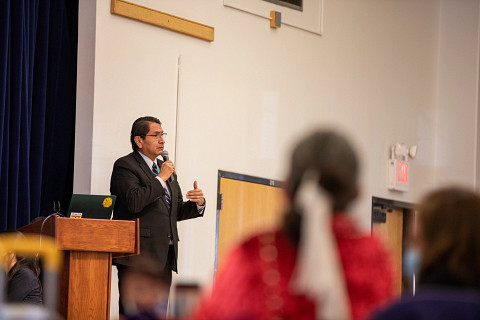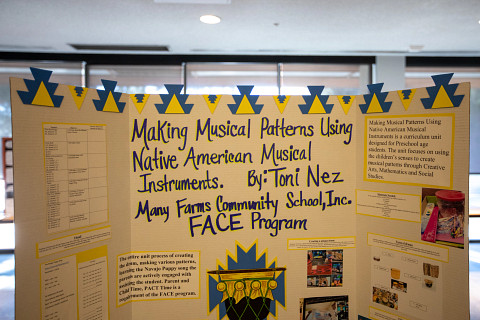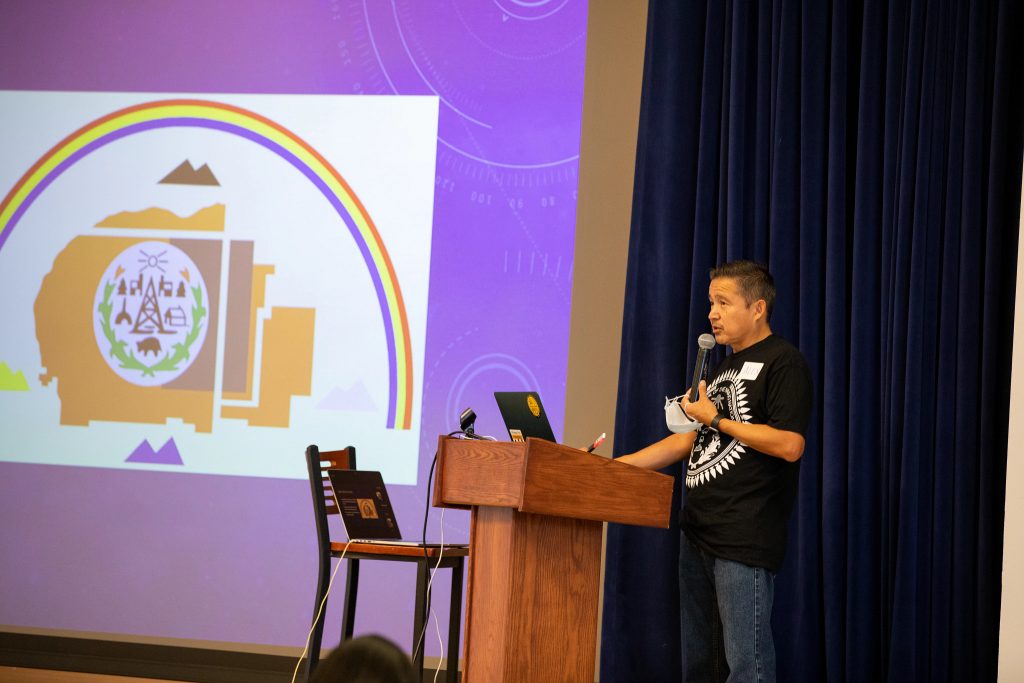What can you learn from a flag?
If it’s the flag of the Navajo Nation and you’re in Alex Gatewood’s classroom at Tséhootsooí Primary Learning Center in Window Rock, you can learn about climate change, the tribe’s history and culture and the importance of trees, and you can learn how to put that knowledge to use outside the classroom.
He showed a picture of the flag, which includes the mountains sacred to the Diné, their lands, a Hogan, coal, a rainbow, oil, ponderosa pines and the sun. Each became a talking point about what the Diné value and how some of those may change in the future in response to climate change.
“I was trying to teach kids to see these elements and to begin thinking about what they should do at their age and as they go through elementary, middle school and high school,” he said. “I want to give students a mindset to start thinking about that so as they get older, they could be the solution to climate change.”
Gatewood, who is a fellow of NAU’s Diné Institute for Navajo Nation Educators (DINÉ), was one of a few dozen educators who presented their innovative, Indigenous-centered curriculum at the fourth annual showcase and open house held Dec. 4 on the Flagstaff campus.
The showcase, which brought together more than 100 educators who are part of DINÉ and the Indigenous Early Childhood Educators (IECE) Fellowship, offers an opportunity for educators to discuss culturally responsive teaching in Indigenous communities and celebrate all their hard work and creativity in the classroom.
“The showcase allows teachers to see the incredible work their colleagues have completed, and that inspires them to consider how they can develop curriculum that is simultaneously culturally responsive and academically rigorous,” said Angelina Castagno, DINÉ director and professor of educational leadership and foundations. “Teachers are such important community leaders, but they aren’t always treated with the respect they and their profession deserve. The DINÉ, IECE and all of our programs through the Institute for Native-serving Educators seek to elevate the expertise of teachers and celebrate their efforts to leverage Indigenous cultures, knowledges, histories and languages to connect with students.”
Launched in 2018, DINÉ is a Yale University-backed partnership between NAU and schools on and bordering the Navajo Nation. It is the first Yale partnership serving rural communities or working with a tribal nation. DINÉ’s mission is to strengthen teaching in K-12 schools that serve Navajo students by engaging educators in long-term professional development seminars to increase content knowledge, curriculum development, leadership skills and the capacity to deliver cultural lessons. The IECE program was launched this year to bring a similar model of professional development to preschool teachers serving Native students.
“Empowering teachers for success and integrating culture into classrooms helps improve the inequitable educational outcomes that Indigenous students face due to a history of colonization and assimilation,” Castagno said.
NAU President José Luis Cruz Rivera, who welcomed event attendees, also discussed the importance of decolonization in educating students.

“The United States has a long history of colonizing and assimilatory education in Native communities, which has resulted in the patterned inequitable outcomes we see today,” he said. “We have a responsibility to disrupt these patterns, and partnering with Indigenous educators and leaders to develop professional development programs like DINÉ and IECE is one way to fulfill that responsibility.”
Navajo Nation President Jonathan Nez and First Lady Phefelia Nez were the keynote speakers; both spoke about the importance of centering Native experiences in the classroom. President Nez introduced himself in Diné and spoke about his own upbringing and reminisced about his grandmother rousting him out of bed early in the morning so he could go about his day.
“The reason why I bring that up is it’s very important that we integrate our way-of-life teaching into curriculum today,” President Nez told the assembled educators. “Sovereignty and education—that is what we’re talking about. The Diné need to have control over our curriculum, using our way of life teaching—what we were raised with—and handing that down to our next generation.”
Phefelia Nez also spoke about the important role the educators played in their students’ lives and educations.
“As teachers, you shape learning and development and play a major part on the path a child takes,” she said. “You build the self-esteem of students and impact the development of their moral growth, but perhaps the most important characteristic of an effective teacher is to emulate the traits of a life-long learner. Teachers who demonstrate a love for learning often pass this passion to their students in the classroom.”
In addition to Gatewood, five other teachers presented their experiences being in their classrooms and how others could build on those lessons. Topics included

using photography to teach history, beading to teach math, learning about climate change through Betatakin Canyon, which is home to ancient cliff dwellings, and creating a classroom constitution. In each case, the goal was to promote innovation and culturally responsive learning.
Participants also got to explore more than two dozen curriculum unit displays that explained different teaching approaches and lessons plans. Tactile and colorful lessons illustrated how teachers are weaving Navajo, Hopi and Gila River traditions with science, math, language arts and social studies.
Navajo Nation Acting Superintendent Patricia Gonnie discussed the importance of integrating culture as early as preschool, and the way curriculum developed by DINÉ and IECE teachers can improve student success in Native communities. Other presenters included Ron Lee, NAU senior director of development, and Interim Vice President for Native American Initiatives Ann Marie Chischilly.




